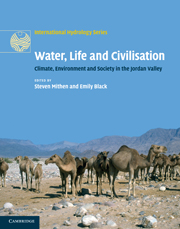Book contents
- Frontmatter
- Contents
- List of figures
- List of tables
- List of contributors
- Acknowledgements
- 1 Introduction: an interdisciplinary approach to Water, Life and Civilisation
- Part I Past, present and future climate
- Part II The palaeoenvironmental record
- Part III Hydrological studies of the Jordan Valley
- Part IV Human settlement, climate change, hydrology and water management
- Part V Palaeoeconomies and developing archaeological methodologies
- Part VI Society, economy and water today
- Part VII Conclusions
- Index
- Plate section
- References
1 - Introduction: an interdisciplinary approach to Water, Life and Civilisation
Published online by Cambridge University Press: 26 April 2011
- Frontmatter
- Contents
- List of figures
- List of tables
- List of contributors
- Acknowledgements
- 1 Introduction: an interdisciplinary approach to Water, Life and Civilisation
- Part I Past, present and future climate
- Part II The palaeoenvironmental record
- Part III Hydrological studies of the Jordan Valley
- Part IV Human settlement, climate change, hydrology and water management
- Part V Palaeoeconomies and developing archaeological methodologies
- Part VI Society, economy and water today
- Part VII Conclusions
- Index
- Plate section
- References
Summary
This volume is an outcome of a five-year research project (2005–2009) based at the University of Reading, UK, entitled Water, Life and Civilisation. This project's aim was:
to assess the changes in the hydrological climate of the Middle East and North Africa (MENA) region and their impact on human communities between 20,000 BP and AD 2100, with a case study of the Jordan Valley.
The project arose from a decision by the Leverhulme Trust to fund one or more projects under the heading ‘Water, Life and Civilisation’, each funded by an award of up to £1.25 million, advertising for applications in October 2003. Quite why the Leverhulme Trust selected this theme is unknown, but it was one that provided an ideal fit to research interests within the School of Human and Environmental Sciences at the University of Reading. The School had been formed in August 2003 from the previous Departments of Archaeology, Geography, and Soil Science, and the Postgraduate Research Institute for Sedimentology, with the avowed aim of developing interdisciplinary research. There was already research collaboration between Archaeology and the Department of Meteorology, exploring the impact of Pleistocene climate change on hominin dispersals from Africa (Hughes and Smith, 2008; Smith et al., in press). In light of expertise within Geography regarding hydrology and development studies, and within Archaeology regarding the emergence of complex society, the Leverhulme Trust's request provided an excellent opportunity to realise the potential for interdisciplinary research provided by the new School; moreover it would be able to do so by addressing a research theme of global significance.
- Type
- Chapter
- Information
- Water, Life and CivilisationClimate, Environment and Society in the Jordan Valley, pp. 1 - 10Publisher: Cambridge University PressPrint publication year: 2011



